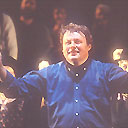
From the back of the arena, a huge Welsh flag greeted the country's national orchestra and chorus as they arrived for this Prom. It was being waved proudly at the end, though it had taken almost until then for the performance to really get into its stride.
The main work on the programme - Dvorak's Stabat Mater - would have formed a substantial enough concert by itself. But this is still Walton's centenary year, and as an overture we had the little-known suite from the incidental music he wrote for Louis MacNeice's 1942 radio play, Christopher Columbus.
The suite fitted well into the Spanish theme of this year's Proms, with the outer two movements being full of zesty Mediterranean rhythms, the tambourine rarely silent. But it was the Romanza in between - entitled Beatriz' Song - that was the highlight, its haunting, almost folk-like melody sung meltingly by Catherine Wyn Rogers. Plucked from the context of the radio play, the bombastic postlude of the first movement seemed pointlessly repetitive; Beatriz' Song, however, stands on its own.
Dvorak himself conducted his Stabat Mater here in the Albert Hall in 1884. It is his earliest choral work, with a very personal and spiritual motivation: he began it soon after the death of a daughter, and two more of his children had died by the time he completed it 18 months later.
The quartet of soloists here did the work proud. Wyn Rogers and the tenor Paul Charles Clarke were retained from the Walton; they were joined by Janice Watson, her soprano understated yet gleaming, and John Tomlinson, declaiming his lines ardently without losing focus.
The orchestra, however, were slightly shaky in the opening unisons, and the massed forces of the BBC National Chorus of Wales and the London Symphony Chorus seemed to need more incisive guidance than the conductor Richard Hickox gave them. The woodwind bore tirelessly the burden that Dvorak's distinctive scoring places on them, yet could have been better blended. The work only really took flight with the final movement. Then, however, we heard a fitting culmination, and the thrilling unaccompanied singing from the chorus demonstrated that it was worth using two choirs.

